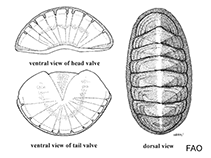Ischnochiton comptus (Gould, 1859)
Fancy chitonWarning: DOMDocument::load(): SSL operation failed with code 1. OpenSSL Error messages: error:140770FC:SSL routines:SSL23_GET_SERVER_HELLO:unknown protocol in C:\Apache24\htdocs\includes\SpeciesSummary.lib.php on line 1236
Warning: DOMDocument::load(): Failed to enable crypto in C:\Apache24\htdocs\includes\SpeciesSummary.lib.php on line 1236
Warning: DOMDocument::load(https://sealifebase.nrm.se/webservice/AquaMaps/getAMap.php?genus=Ischnochiton&species=comptus): failed to open stream: operation failed in C:\Apache24\htdocs\includes\SpeciesSummary.lib.php on line 1236
Warning: DOMDocument::load(): I/O warning : failed to load external entity "https://sealifebase.nrm.se/webservice/AquaMaps/getAMap.php?genus=Ischnochiton&species=comptus" in C:\Apache24\htdocs\includes\SpeciesSummary.lib.php on line 1236
Upload your photos
Google image | No image available for this species;
drawing shows typical species in Ischnochitonidae.
Google image | No image available for this species;
drawing shows typical species in Ischnochitonidae.
Classification / Names Common names | Synonyms | CoL | ITIS | WoRMS
| Chitonida | Ischnochitonidae
Environment: milieu / climate zone / depth range / distribution range Ecología
. Subtropical
Distribución Países | Áreas FAO | Ecosistemas | Ocurrencias, apariciones | Introducciones
Western Pacific: Japan, south to the Philippines.
Length at first maturity / Tamaño / Peso / Age
Maturity: Lm ? range ? - ? cm Max length : 2.5 cm TL macho / no sexado; (Ref. 283)
Short description Morfología
Valves broad; mostly light grayish brown; variously blotched with white, cream, pink, reddish chestnut or blackish brown; some specimens are olive colored mottled with white. Valve surface microgranulose, sculptured with numerous weak, glossy, radiating riblets. Girdle scaly and colored in alternating yellowish and grayish or brownish bands.
Found from intertidal to 50 m, on rocks and gravel (Ref. 75835). Also found under stones, just before Sargassum (Ref. 128661).
Life cycle and mating behavior Madurez | Reproducción | Puesta | Huevos | Fecundidad | Larva
Members of the class Polyplacophora are mostly gonochoric. Life cycle: Eggs hatch into lecitotrophic planktonic trocophore larvae (no veliger stage) which later metamorphose and settle on the bottom as young adults.
Main reference
Referencias | Coordinador | Colaboradores
Burghardt, G. and L. Burghardt. 2006. (Ref. 283)
IUCN Red List Status (Ref. 130435)
CITES status (Ref. 108899)
Not Evaluated
CMS (Ref. 116361)
Not Evaluated
Threat to humans
Harmless
Human uses
| FishSource |
Herramientas
Más información
Países
Áreas FAO
Ecosistemas
Ocurrencias, apariciones
Introducciones
Stocks
Ecología
Dieta
componentes alimenticios
Áreas FAO
Ecosistemas
Ocurrencias, apariciones
Introducciones
Stocks
Ecología
Dieta
componentes alimenticios
Fuentes de Internet
BHL | BOLD Systems | CISTI | DiscoverLife | FAO(Publication : search) | Fishipedia | GenBank (genome, nucleotide) | GloBI | Gomexsi | Google Books | Google Scholar | Google | PubMed | Árbol de la vida | Wikipedia (Go, búsqueda) | Expediente Zoológico
Estimates based on models
Price category
(Ref. 80766):
Unknown.



